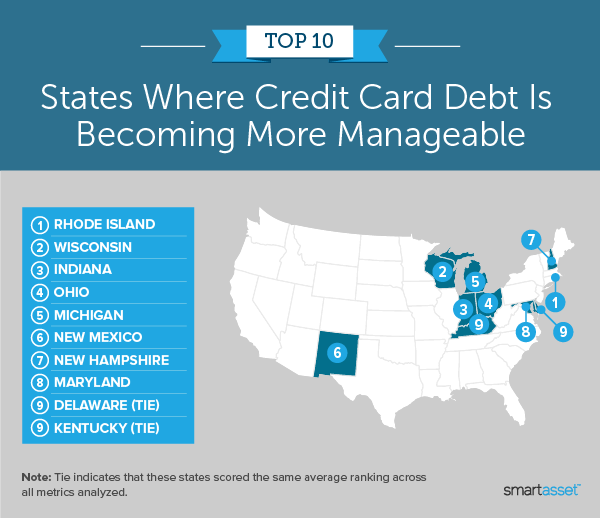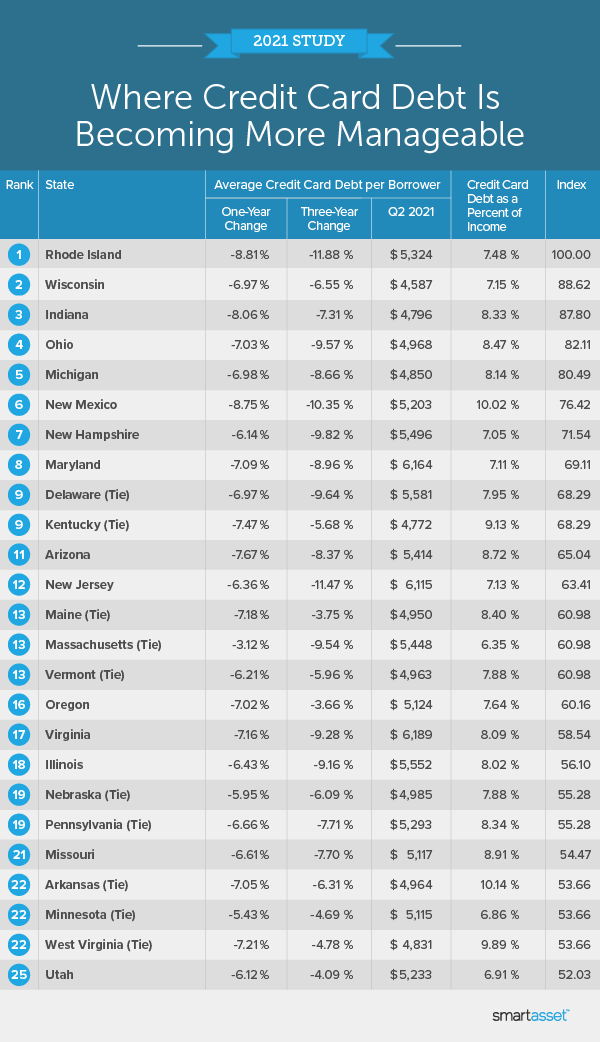Credit cards can be useful, especially if you use them responsibly to gain points, airline miles and other perks. That said, it is easy to let your credit card debt get out of control and end up in serious trouble. For the second quarter of 2021, Experian says that the average card balance was $5,525 nationally, which is actually down from three years ago from when it stood at $6,505. Keeping this in mind, SmartAsset ranked the states where debt is becoming more manageable for consumers.
For this study, we considered the following metrics: average credit card debt, credit card debt as a percentage of median income, three-year change in credit card debt and one-year change in credit card debt. For more details on how we found and analyzed our data, read the Data and Methodology section below.
Key Findings
- Debt is down. Nationwide, average credit card debt is down 6.55% over the past three years. In fact, there is only one state where credit card debt has increased since 2018 – in North Dakota it has gone up 1.18%.
- Midwest and East Coast dominate the top. Eight out of the top 10 states where credit card debt is becoming more manageable are located in the Midwest and East Coast. These include Rhode Island, New Hampshire, Maryland and Delaware on the East Coast; and Wisconsin, Indiana, Ohio and Michigan in the Midwest. New Mexico in the Southwest and Kentucky in the South round out the top 10.

1. Rhode Island
Rhode Island leads this study in credit card debt reduction over both three years and one year, going down 11.88% and 8.81% respectively. That said, it’s still in the middle of the pack in terms of the average debt, placing 26th at $5,324.
2. Wisconsin
The average credit card debt in Wisconsin is just $4,587, the lowest in the nation. That represents 7.15% of median income, the ninth-lowest percentage observed in this study. Debt went down 6.55% over the past three years, placing the state at 24th out of 51 for this metric.
3. Indiana
Indiana has the fourth-lowest average debt in the nation, just $4,796. That’s a 8.06% drop from the average of $5,216 in 2020, the fourth-biggest one-year difference observed in this study. The three-year change is a 7.31% drop, ranking 22nd.
4. Ohio
Ohio saw average credit card debt go down 9.57% from 2018 to 2021, the seventh-biggest three-year drop recorded in this study. The average Q2 2021 debt is $5,494. That’s 8.47% of the median income, ranking Ohio 30th in that metric.
5. Michigan
Michigan has the seventh-lowest Q2 2021 median debt, sitting at $4,850. That is a 8.66% decrease over three years and a 6.98% decrease over one year, ranking 15th and 19th respectively.
6. New Mexico
New Mexico ranks 34th for average Q2 2021 credit card debt ($5,203). It has the fourth-biggest three-year change with a 10.35% decline from 2018. And also the second-biggest one-year change, going down 8.75% from 2020.
7. New Hampshire
The median Q2 2021 credit card debt in New Hampshire is $5,496, ranking 31st overall for this metric. That said, it makes up 7.05% of the median income in the state, placing the Granite State sixth-lowest in that metric. This is also a drop of 9.82% from 2018, ranking fifth.
8. Maryland
Maryland actually ranks near the bottom of this study for credit card debt in Q2 of 2021, finishing 46th at $6,164. That debt, however, makes up only 7.11% of median income, the seventh-lowest in the study. Maryland finishes 13th for both metrics measuring change, with debt going down 8.96% over three years and 7.09% over one year.
9. Delaware
Delaware saw average credit card debt go from $6,176 in 2018 to $5,581 in Q2 of 2021, the sixth-largest drop (9.64%) in this study. The 2021 debt average makes up 7.95% of median income in the state, placing 19th-lowest.
10. Kentucky
Kentucky’s average Q2 2021 credit card debt is $4,772, the third-lowest in the nation. That is a 7.47% drop from 2020, which is the seventh-biggest one-year drop observed in this study. The figure makes up 9.13% of the median income in Kentucky, ranking 36th.

Data and Methodology
To find the states where credit card debt is becoming more manageable, we compared all 50 states plus Washington, D.C. across the following metrics:
- Average credit card debt 2021. Data is for the second quarter of 2021 and comes from Experian.
- 2021 average credit card debt as a percentage of median income. Debt figure comes from Experian and income figure comes from the 2019 1-year American Community Survey.
- Three-year change in average credit card debt. Data comes from Experian and is for 2018 and 2021.
- One-year change in average credit card debt. Data comes from Experian and is for 2020 and 2021.
First, we ranked each state in each metric. We then found every state’s average ranking, weighting every metric equally. We ranked the states according to this average ranking, giving an index score of 100 to the top state and an index score of 0 to the bottom state.
Tips for Managing Credit Card Debt
- Which card is best for you? If you do use credit cards, make sure you’re getting the best rate and the best perks available. Read SmartAsset’s guide to get the card that is best for you and your situation.
- Prioritize paying off debt, if possible. Do you have a debt you need to pay off? One way is to set aside some money each month to chip away at the debt. Use SmartAsset’s budget calculator to set up a spending plan that includes paying off a portion of your debt each month.
- Seek expert advice if you feel it’s right for you. A financial advisor can also help you create a plan to take greater control of your finances. SmartAsset’s free tool matches you with up to three financial advisors in your area, and you can interview your advisor matches at no cost to decide which one is right for you. If you’re ready to find an advisor who can help you achieve your financial goals, get started now.
Questions about our study? Contact press@smartasset.com.
Photo credit: ©iStock.com/Delmaine Donson
